Hi, there 👋. Welcome to the accountantguy.
Today, we are going to learn how we can create this fantastic minimalistic Couple’s Finance Tracker to monitor and manage the finances of couples by keeping track of their incomes, expenses, and savings funds. It helps couples to stay on top of their finances and set priorities for their savings in due course of time for their livelihood.
Our tracker seamlessly integrates with your Notion account and allows you to easily categorize your expenses, and income and assign the priorities for the savings funds to help manage your financial performance as a couple.

Here are some important things you need to know first before we dive deep into the process of creating this Couple’s Finance Tracker.
Benefits of Couple’s Finance Tracker
Here are 5 prominent benefits of using this minimalistic Couple’s Finance Tracker:
- Keep track of your income and expenses in one central location 💰
- Fix your monthly savings goals to prioritize your savings 🎯
- Assess savings funds and contribution to total overall savings by him 🙋♂️
- Assess savings funds and contribution to total overall savings by her 🙋♀️
- Access your couple’s finance tracker from any device, anywhere 📱
Where can I download the Couple’s Finance Tracker?
You can download this Couple’s Finance Tracker from here.
You can also visit theaccountantguy.gumroad.com to check out more templates.
Check it out NOW!!! 🔥
More: How to build Notion Debt Tracker
Features of using this Couple’s Finance Tracker
This minimalistic Couple’s Finance Tracker has the following 3 segments in the dashboard:
Summary

The summary segment has 3 sub-sections namely All, Him, and Her.
Each of the sub-section has its own use for the calculation of the Couple’s Finance Tracker.
Let’s first start with the sub-section denoted by All.
This shows an overall summary of all the savings of the funds that have been made by the couple till now.
Here are the things noticeable for the Couple’s Finance Tracker in the summary segment:
- Goal – This shows the targeted amount of savings that are needed to be done by the couple.
- Amount saved – This shows the amount of savings done to date by the couple.
- Amount Left – This shows the amount left to be saved by the couple to reach the targeted savings amount.
- Savings to Goal (in %) – This shows the amount of savings made in comparison to the targeted amount of savings required.
- Available Funds Saved (in %) – This shows the amount of the funds that have been put into savings (in %) as compared to the funds available in hand.
Note: The above information is pulled from another database, i.e. DB Summary database (to be discussed further)

Summary (Him/Her)

In this sub-section, we are doing the calculation related to savings and its necessary components for either Him / Her.
Here are the components we have under each of the sub-section:
- Goal – This shows the targeted goal amount to be saved by either him/her while creating a savings fund.
- Amount Saved – This shows the amount of savings made by either him/her over the course of time.
- Amount Left – This shows the amount of savings left to be made by either him/her while creating the savings funds.
- Savings to Goal (in %) – This shows the amount of savings made in comparison to the total amount of the targeted amount of savings required by either him/her.
- Total Earnings – This shows the total earnings made by either him/her during the course of time.
- Total Spending – This shows the total spending made by either him/her during the course of time.
- Proportion of Total Savings (in %) – This shows the proportion of the amount saved (in %) by either him/her in comparison to the total savings made to date by both.
Note: The above information is pulled from another database, i.e. DB Husband and Wife Contribution (to be discussed further).
Financials Overview

Next up, we have the Financials Overview wherein we calculate the Income, Expenses and gather the details related to the bank accounts as well.
Each of the 3 sub-sections has a different use in the context of the Couple’s Finance Tracker.
Income

Under the Income sub-section, we have the following details:
- Date – This indicates the date of occurrence of putting the income details.
- Details – This indicates the details of income such as Salary, Side Hustle, and Other Incomes.
- Amount – This indicates the amount of income for each of the sources of income.
- Account – This indicates the bank account wherein the account of earnings will be deposited such as Salary Account, Emergency Account, Vacation Account etc.
- Earned By – This indicates the person who has earned the income, i.e. either the Husband (Him) or Wife (Her).
Note: The above information is pulled from another database, i.e. the DB Income database (to be discussed further).

Expense

Under the Expense sub-section, we have the following details:
- Date – This indicates the date of occurrence of putting the income details.
- Details – This indicates the details of income such as Salary, Side Hustle, and Other Incomes.
- Amount – This indicates the amount of income for each of the sources of income.
- Account – This indicates the bank account wherein the account of earnings will be deposited such as Salary Account, Emergency Account, Vacation Account etc.
- Spent By – This indicates the person who has spent the income, i.e. either the Husband (Him) or Wife (Her).
Note: The above information is pulled from another database, i.e. the DB Expense database (to be discussed further).

Account
Finally, we have the accounts section, which shows the bank accounts where we are maintaining all our transaction details.

Under this sub-section, we have the following details:
- Name – This indicates the bank account associated with the transactions that we undertake during a period.
- Linked To – This indicates the savings account associated with the savings that we undertake as a couple in a relationship.
- Opening Funds – This indicates the opening balance available at the start of the period before savings are created.
- Income – This indicates income earned by either him/her during the period.
- Inflow Amount – This indicates any inflow of funds due to inter-account adjustment between 2 bank accounts.
- Expenses – This indicates expenses made by either him/her during the period.
- Outflow Amount – This indicates any outflow of funds due to inter-account adjustment between 2 bank accounts.
- Available Funds – This indicates the balance available at the end of the period after all the adjustments are carried out.

Savings Funds Overview
Next up, we have Savings Funds Overview, wherein we show 2 things in specific:
Transfers History
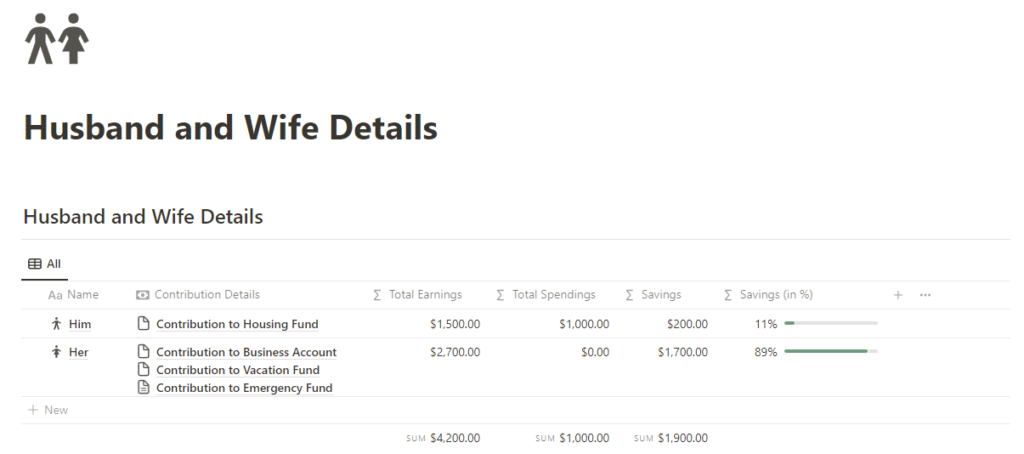
This sub-section shows the transfer of funds made between one account to another and shows the relevant details of it month-wise.
Under this sub-section, we have the following details for our reference:
- Date – This indicates the date of occurrence of the transfer of funds from one account to another.
- Details – This shows the details of the transfer of funds from one account to another.
- Amount – This shows the amount of the transfer made from one account to another.
- Contributed By – This shows the amount of the contribution made by either the Husband or the Wife in the relationship.
- Account From (-) – This shows the account from which the funds are debited or reduced and transferred to another account.
- Account To (+) – This shows the account to which the funds are credited or added to from another account.
- Savings Funds (+) – This shows the fund account which is created when the funds are transferred from one account to another.
Note: This is linked to the DB Transfers database as shown below

Funds Details

This sub-section shows the funds details and their relevant details.
Under this sub-section, we have the following details for our reference:
- Name – This indicates the name of the savings fund that the couple is trying to build over the period of time.
- Goal – This indicates the goal amount of savings funds that the couple is trying to build over the course of time.
- His Goal – This indicates the targeted goal amount of the Husband towards savings in the savings funds.
- Her Goal – This shows the targeted goal amount of the Wife towards savings in the savings funds.
- Amount Saved – This shows the amount that has been saved so far because of the contribution of both Husband and Wife into the savings funds.
- Amount Left – This shows the amount left to save after receiving the contribution from both Husband and Wife into the savings funds.
- Proportion of Total Savings (in %) – This shows the total proportion of savings made over the course of time by both Husband and Wife into the savings funds, indicated in percentage.
Note: This is linked to the DB Fund database as shown below
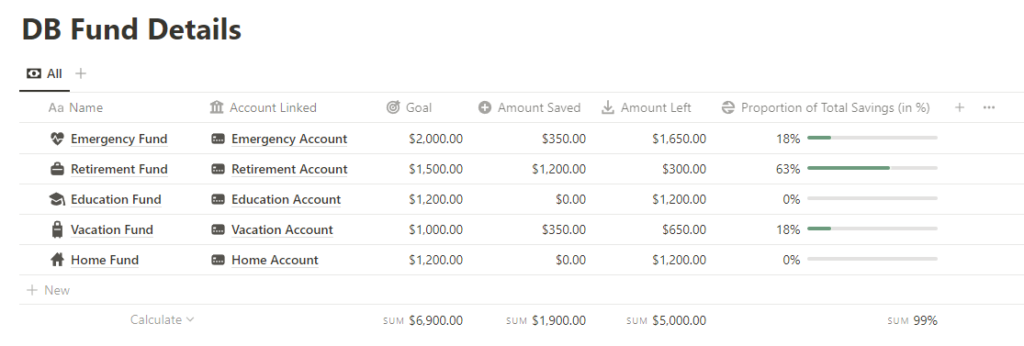
How to create a Couple’s Finance Tracker in Notion?
In order to create the Couple’s Finance Tracker in Notion, we need to create the necessary databases to hold the details of the necessary information that will help to accomplish the desired results.
For this we would need the following things in place to build the tracker from start to finish:

- Accounts
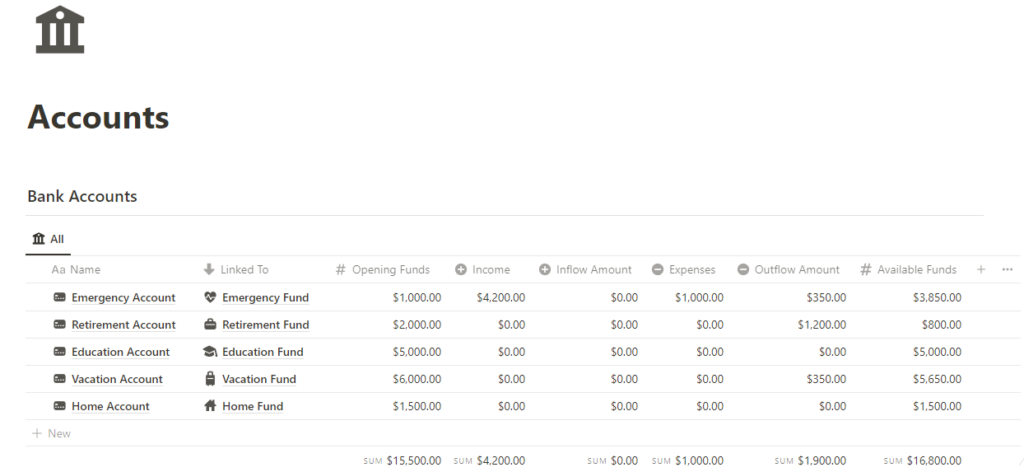
This holds the information related to all the bank accounts of the various savings funds related to different bank accounts that a couple would plan to build over the course of time.
Some of the typical savings funds accounts that can be built are:
- Emergency Fund
- Retirement Fund
- Education Fund
- Vacation Fund
- Home Fund
All these savings funds accounts are linked to different bank accounts that the couple holds together for different purposes.
In a nutshell, under the Accounts section, we are going to specify the different bank accounts the couple would use and the respective savings funds account that can be linked to different bank accounts.
- Incomes
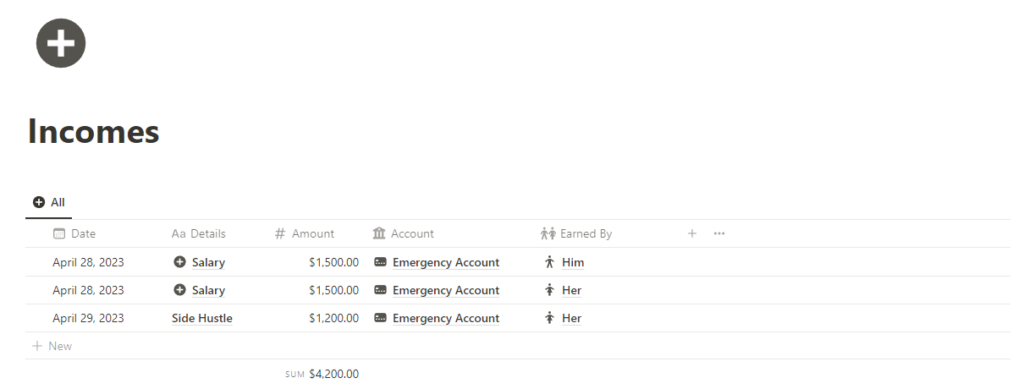
Next up, we have the Incomes section, where we specify the different modes of Incomes earned during the course of time and also specify who earned the income amongst the Husband and Wife as seen above.
- Expenses

Here, we have the Expenses section, where we specify the different modes of Expenses made during the course of time and also specify who made the expenses amongst the Husband and Wife as seen above.
- Husband and Wife Details

This is the last section of the workspace, where we track all the relevant details related to the Husband and Wife and get to know the total savings, incomes, and expenses made over the course of time.
This also indicates the savings (in %) made by each of the people in the relationship.
Let’s get started building this tracker one by one.
Building the Husband and Wife Details
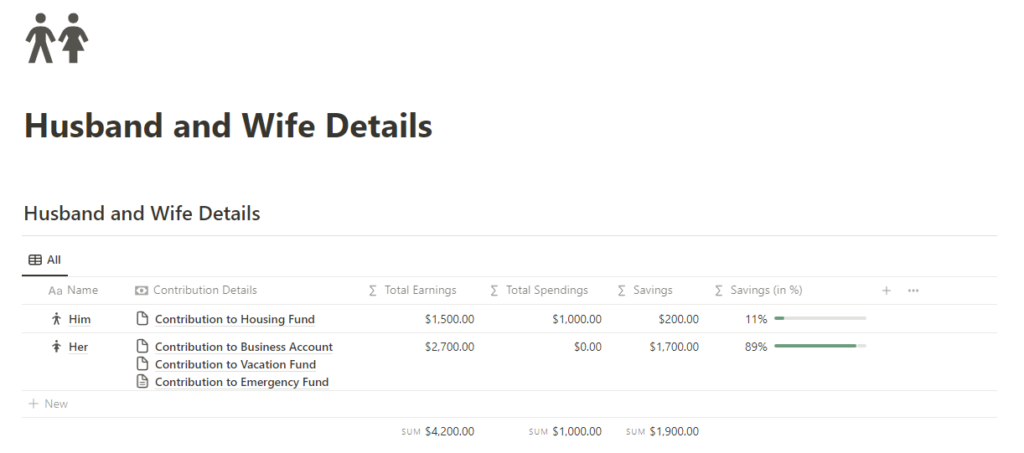
First off, we are building the Husband and Wife Details in a database.
Here, we will essentially store the information related to the Husband and Wife looking to calculate their earnings, spending, savings, and savings (in %) over the course of time.
This database has the following columns:
- Name
This reflects the name of the person in the relationship.
For simplicity’s sake, we have represented here Him and Her for denoting the name of the persons in the relationship denoting Husband and Wife in the relationship.
- Contribution Details
This specifies the contribution made by the person involved in the relationship. This is rolled up from another database as discussed later.
- Total Earnings
This denotes the total earnings earned by the person in the relationship again rolled over from another database.
- Total Spendings
This denotes the total spendings made by the person in the relationship rolled over from another database.
- Savings (in %)
Next up, we have savings denoted in %, which specifies how much savings has been made over the course of time by people in the relationship all calculated in percentage.
Building the Income Database
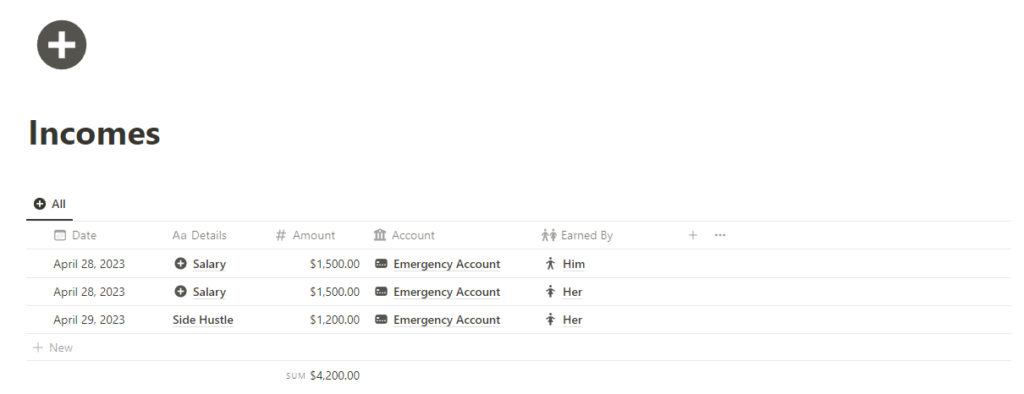
Next up, we have the Incomes Database.
In this database, we have the following columns for use.
- Date
This denotes the date of the transaction where we will add an income detail by either him/her.
- Details
The section denotes the details of the income earned by the person concerned, either him or her, such as Salary, Side Hustle, and more.
- Amount
This denotes the amount of the transaction added as income.
- Account
This is linked to the DB Bank Account where we are linking each of the income to the specific bank account where the income will be credited.
- Earned By
This shows the income earned by any person, i.e. either Him or Her. This is linked to the DB Husband and Wife details (as discussed earlier).
This is the same column as the Name column in the Husband and Wife database.
Building the Expense Database

Next up, we have the Expenses Database.
In this database, we have the following columns for use.
- Date
This denotes the date of the transaction where we will add an expense detail by either him/her.
- Details
The section denotes the details of the expenses spent by the person concerned, either him or her, such as Entertainment, Utilities Bills, Food and Groceries etc.
- Amount
This denotes the amount of the transaction added as expense.
- Account
This is linked to the DB Bank Account where we are linking each of the expense to the specific bank account where the expense will be debited.
- Spent By
This shows the expense made by any person, i.e. either Him or Her. This is linked to the DB Husband and Wife details (as discussed earlier).
This is the same column as the Name column in the Husband and Wife database.
Building the Accounts Database
In the accounts database, we will require the use of 3 databases, i.e.:
- Bank Accounts
- Savings Funds
- Transfers
All these 3 databases are to be created individually for their respective uses as will be discussed below:
Bank Accounts

First, we need to create an inline database by typing “/inline” and it will create an inline database for our use.
In the inline database, we need to enter the following details for our use, as follows:
| Particulars | Purpose |
| Name | Holds the reference for the bank accounts created for the user |
| Linked To | States the reference of the linked savings funds accounts which are linked to the bank accounts (if any) |
| Opening Funds | States the opening balance of the bank accounts when getting started |
| Income | States the income earned with respect to any particular bank account by either Him / Her |
| Inflow Amount | States the inflow of funds (if any) that is a result of inter-transaction in between 2 different bank accounts |
| Expenses | States the expenses made with respect to any particular bank account by either Him / Her |
| Outflow Amount | States the outflow of funds (if any) that is a result of inter-transaction in between 2 different bank accounts |
| Available Funds | States the closing balance of the bank accounts post all transactional changes as shown above. |
This will help to store the relevant information for the bank accounts in use (to be discussed later).
Besides the above, we also have the Savings Funds tracking and also Transfers section which denotes the overall system of tracking other details related to the Bank accounts (to be discussed later).
1. Name

Here the first column denotes the name of the bank account that we want to create.
We can name the same as per our requirement for the same.
2. Linked To

Next up, we have the “Linked To” column, which specifies the savings funds which have been linked to the bank account where we are creating the savings funds for our requirement.
This is related to the DB Fund Details database (as discussed later).
This is the same as Savings Funds database that we have discussed below.

3. Opening Funds

Next up, we have Opening Funds which shows the opening balance of the bank account which has been created by the couple.
This is editable and can be added up as a value by the user.
4. Incomes

This is rolled over from another database, discussed below which shows the income amount added to the respective bank accounts by either Him / Her.
This is linked to the DB Income database.
This is the same as Income Database we had discussed earlier.
5. Inflow Amount

Next up, we have the Inflow Amount which shows inter-adjustments made in between different bank accounts that shows the amount added to the respective bank accounts from other bank accounts.
This will be discussed later as it’s connected to the DB Transfers database.
This is the same as the Transfers database we had discussed earlier.
6. Expenses

Then we have the Expenses amount, which reflects the value of the expense incurred under each bank account by either Him / Her.
This is connected to the DB Expenses database.
This is the same as Expenses Database we had discussed earlier.
7. Outflow Amount

Next up, we have the Outflow Amount which shows inter-adjustments made in between different bank accounts that shows the amount deducted from the respective bank accounts from other bank accounts.
This will be discussed later as it’s connected to the DB Transfers database.
This is the same as the Transfers database we had discussed earlier.
8. Available Funds

Next up, we have the Available Funds section, which shows the funds available at the end of the day for each of the bank accounts.
This is computed after all adjustments considering Opening Balance, Income, Inflow Amount, Expenses, Outflow Amount, etc.
Then we have the Savings Funds database which we have discussed here.
This is a formula property and is thus calculated by the following equation:
Available Funds = Opening Funds + Income + Inflow Amount – Expenses – Outflow Amount
Savings Funds

This database has the following components for use:
1. Name
First off, we have the name of the savings funds which we want to create. So here, we have named the funds as shown above.
2. Account Linked
Then we have the Account Linked column, which reflects the bank account which is linked to the savings funds we are trying to create in the process.
This is connected to DB Bank account as we discussed above.
3. Goals

Next up, we have the Goals section which is rolled up another database that considers the total savings goals for both the people in the relationship, i.e. Him and Her.
This is the sum of both the goals added up, i.e. His Goal and Her Goal added up together.
4. Amount Saved

This shows the total savings made by both the persons combined into one fund. The values are rolled up from another database (to be discussed later).
This is connected to the DB Transfers database where we roll up the desired values of the total amount saved.
Here we are rolling up the total savings amount saved by both Him and Her from the Transfers database.
5. Amount Left

This shows the amount left to be saved after the amount saved or contributed towards savings funds earlier.
This is thus nothing but the goal amount less amount saved.
Then we have Amount Saved, which is equal to Goal Amount less Amount Saved.
This means Amount Left = Goal Amount – Amount Saved.
6. Proportion of Total Savings (in %)

This shows the proportion of the total savings made over the course of time. Thus this shows the total amount saved as compared to the targeted goal amount.
This is equal to the Total Amount Saved divided by the Goal Amount.
Thus Proportion of Total Savings (in %) = Total Amount Saved / Goal Amount.
Transfer

Next up, we have the Transfers database which shows the amount that is transferred from one account to another and transactions in between.
This database has the following things included in the database:
1. Date

This shows the date on which we are transferring the funds from one account to another.
2. Details

This shows the details of the transfers that are represented by any contribution towards a particular fund or otherwise.
Thus this represents any contribution or transfers that would come from one account to another such as
- Between the bank accounts.
- Between the bank account and savings funds etc.
All the above transactions would be taken care of using the Transfers section as depicted above.
3. Amount

In this column, we enter the desired amount of the contribution we are looking to create that is either made by Him or Her in the relationship.
This is an editable field and we can enter the value of the contribution in the field.
4. Contributed By

Next up, we have Contributed By column which shows the person who has contributed the funds in the relationship.
This is linked to DB Husband and Wife Details as we had discussed earlier.
So essentially we are linking the same to the Husband and Wife details database, and then linking the desired person who is making the contribution to the savings as discussed.
5. Account From (-)

Next up, we have the Account From (-) column, which shows the account from where the money is taken out.
This indicates the bank account which is used for the transfers of funds from one account to another.
Again this is linked to the DB Bank account and denotes the bank accounts from where the money is debited from.
6. Account To (+)

This indicates the bank account to which the amount is credited to and is transferred from one account to another.
Essentially, Account From (-) and Account To (+) are both linked to DB Bank account database and are used to showcase the bank accounts where money is debited and credited to respectively.
7. Savings Fund (+)

Next up, we have the Savings Fund (+) which shows the savings account which is linked to the bank account through Account From (-).
Essentially, here we represent the savings funds account which is linked to the bank account.
This means we are adding up the desired savings accounts where we are putting the money in from our bank accounts.
As an example, this could be money transferred from Savings Accounts to the Savings Account.
So in this case, the bank account indicated would be in Account From (-) from where money is debited and then it would be Savings Funds (+) where money is credited to.
This brings us to the end of the discussion on How to build a Couple’s Finance Tracker in Notion.
I hope we have learned something new in the entire discussion up until this point.
Conclusion
This brings us to the end of the preparation of this minimalistic Notion Couples Tracker.
In order to create the Notion Couples Tracker, all we need is a database to hold all the details of the finances related to the couples and secondary databases to supplement further analysis.
